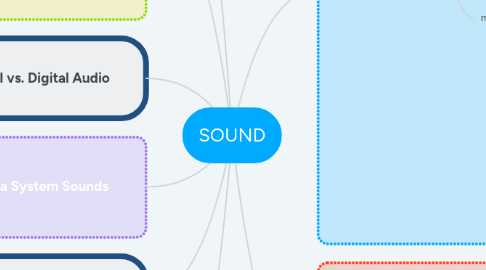SOUND
by Thu Hải Nguyễn


1. the power of sound
1.1. Sound pressure levels (loudness or volume) are measured in decibels (dB)
1.2. Acoustics is the branch of physics that studies sound
2. digital audio
2.1. a process referred to as digitizing
2.1.1. from a microphone, a synthesizer, existing recordings, live radio and CD and DVDs
2.2. making digital audio files
2.2.1. Setting Proper Recording Levels
2.2.2. Editing Digital Recordings
2.2.2.1. Trimming
2.2.2.2. Splicing and Assembly
2.2.2.3. Volume Adjustments
2.2.2.4. Format Conversion
2.2.2.5. Resampling or Downsampling
2.2.2.6. Fade-ins and Fade-outs
2.2.2.7. Equalization
2.2.2.8. Time Stretching
2.2.2.9. Digital Signal Processing (DSP)
2.2.2.10. Reversing Sounds
2.2.2.11. Multiple Tracks
2.2.3. File Size vs. Quality
3. MIDI Audio
3.1. a communications standard developed in the early 1980s for electronic musical instruments and computers
3.2. To make MIDI scores
3.2.1. notation software
3.2.2. sequencer software
3.2.3. sound synthesizer
3.2.4. MIDI keyboard
3.2.5. General MIDI
4. MIDI vs. Digital Audio
5. Multimedia System Sounds
5.1. In Windows : WAV files
5.2. In OS X on a Macintosh : AIF format
6. Audio File Formats
6.1. s Linear Pulse Code Modulation (LPCM)
6.2. CD-ROM/XA
6.3. AIFF
6.4. WAV
6.5. MPEG
6.6. .mov
6.7. codec
7. Vaughan’s Law of Multimedia Minimums
8. Adding Sound to Your Multimedia Project
8.1. Space Considerations
8.2. Audio Recording
8.2.1. Digital audio tape (DAT)
8.3. Keeping Track of Your Sounds
8.4. Audio CDs
8.4.1. Red Book Audio
8.5. Sound for Your Mobile
8.6. Sound for the Internet
8.6.1. buffer
8.6.2. Streaming
8.7. Testing and Evaluation
8.7.1. post-production or a post session
